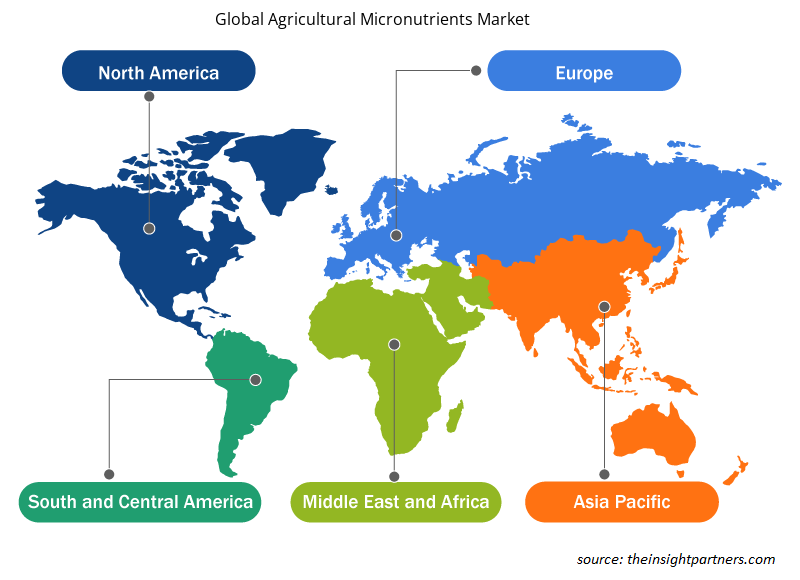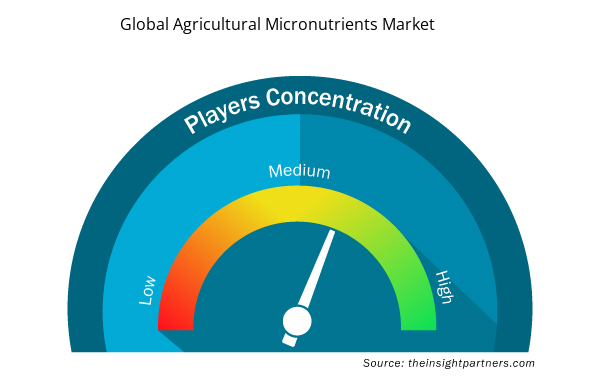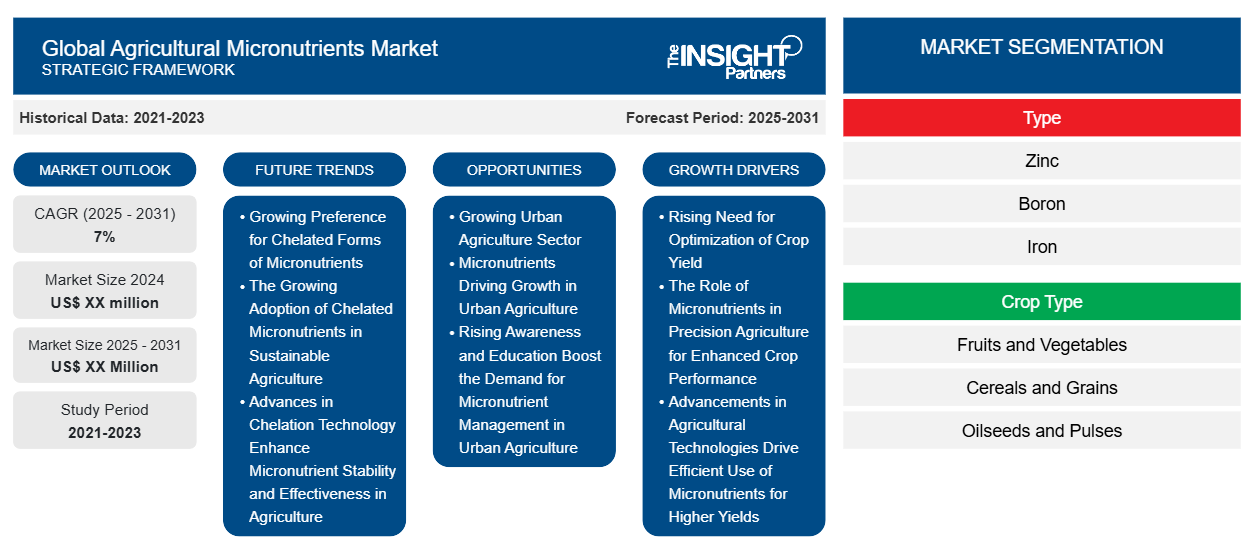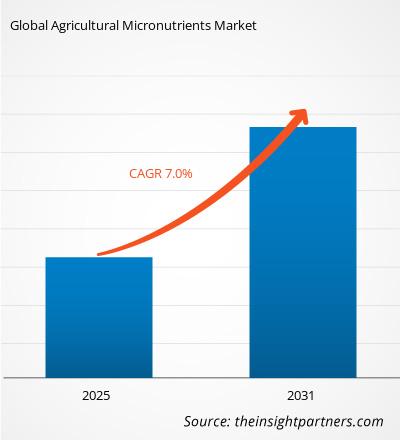Le marché des micronutriments agricoles devrait enregistrer un TCAC de 7 % de 2024 à 2031, avec une taille de marché passant de XX millions USD en 2024 à XX millions USD d'ici 2031.
Le rapport est segmenté par type (zinc, bore, fer, molybdène, cuivre, manganèse et autres). Le rapport présente en outre une analyse basée sur le type de culture (fruits et légumes, céréales et grains, oléagineux et légumineuses et autres). Le rapport basé sur la forme est segmenté en (chélaté et non chélaté). Le rapport basé sur le mode d'application est segmenté en (sol, feuillage, fertirrigation et autres). L'analyse globale est ensuite décomposée au niveau régional et par principaux pays. Le rapport offre la valeur en USD pour l'analyse et les segments ci-dessus.
Objectif du rapport
Le rapport sur le marché des micronutriments agricoles de The Insight Partners vise à décrire le paysage actuel et la croissance future, les principaux facteurs moteurs, les défis et les opportunités. Cela fournira des informations à diverses parties prenantes commerciales, telles que :
- Fournisseurs/fabricants de technologie : pour comprendre l’évolution de la dynamique du marché et connaître les opportunités de croissance potentielles, leur permettant de prendre des décisions stratégiques éclairées.
- Investisseurs : Effectuer une analyse complète des tendances concernant le taux de croissance du marché, les projections financières du marché et les opportunités qui existent tout au long de la chaîne de valeur.
- Organismes de réglementation : Réglementer les politiques et surveiller les activités du marché dans le but de minimiser les abus, de préserver la confiance des investisseurs et de maintenir l’intégrité et la stabilité du marché.
Segmentation du marché des micronutriments agricoles
Taper
- Zinc
- Bore
- Fer
- Molybdène
- Cuivre
- Manganèse
Type de culture
- Fruits et légumes
- Céréales et grains
- Oléagineux et légumineuses
Formulaire
- Chélaté et non chélaté
Géographie
- Amérique du Nord
- Europe
- Asie-Pacifique
- Amérique du Sud et Amérique centrale
- Moyen-Orient et Afrique
Personnalisez ce rapport en fonction de vos besoins
Vous bénéficierez d'une personnalisation gratuite de n'importe quel rapport, y compris de certaines parties de ce rapport, d'une analyse au niveau des pays, d'un pack de données Excel, ainsi que de superbes offres et réductions pour les start-ups et les universités.
- Obtenez les principales tendances clés du marché de ce rapport.Cet échantillon GRATUIT comprendra une analyse de données, allant des tendances du marché aux estimations et prévisions.
Facteurs de croissance du marché des micronutriments agricoles
- Besoin croissant d'optimisation du rendement des cultures : L'un des impacts majeurs qui sera accordé au marché des micronutriments agricoles sera l'augmentation de l'optimisation du rendement. Cela proviendra de la tendance des agriculteurs à améliorer la productivité et la qualité des cultures, ce qui entraînera une demande accrue de micronutriments tels que le zinc, le fer et le manganèse. Il s'agit de l'un des éléments essentiels de la santé et du rendement des plantes, en particulier dans des conditions environnementales défavorables.
- Le rôle des micronutriments dans l’agriculture de précision pour améliorer les performances des cultures : La croissance rapide de la population s’accompagne d’un besoin d’optimisation de la production agricole, ainsi que d’une insécurité alimentaire. Pour combler les carences en éléments qui limiteraient autrement les performances des cultures, les agriculteurs utilisent de plus en plus d’engrais et d’amendements du sol sur les champs. Cette focalisation sur l’agriculture de précision renforce encore la sensibilisation au rôle des micronutriments dans la pratique durable de l’agriculture.
- Les progrès des technologies agricoles favorisent une utilisation plus efficace des micronutriments pour des rendements plus élevés : De même, l’intensité élevée de l’application des micronutriments est également due aux technologies agricoles. Grâce à des systèmes améliorés d’analyse des sols et de gestion des nutriments, les agriculteurs sont généralement en mesure d’augmenter leurs intrants avec plus de soin, non seulement pour des rendements plus rémunérateurs, mais aussi pour une utilisation plus économique des ressources afin d’assurer une plus grande rentabilité des opérations agricoles.
Tendances futures du marché des micronutriments agricoles
- Préférence croissante pour les formes chélatées de micronutriments : L’une des nouvelles tendances en matière de micronutriments agricoles est la demande croissante de formes chélatées de micronutriments. Les micronutriments chélatés sont des micronutriments chélatés à des molécules organiques, qui offrent une plus grande biodisponibilité que les formes traditionnelles et, par conséquent, une meilleure absorption par les plantes et un meilleur rendement des cultures.
- L'adoption croissante des micronutriments chélatés dans l'agriculture durable : Un autre avantage des applications de micronutriments chélatés signalé par les agriculteurs est la correction ciblée des carences en nutriments spécifiques dans les sols. À mesure que la prise de conscience environnementale envers la gestion des nutriments s'intensifie, ces formes sont facilement adoptées comme mode par de plus en plus d'agriculteurs pour améliorer la santé et le rendement des plantes. Cette tendance concorde avec l'appel lancé à toutes les nations du monde pour adopter une agriculture durable.
- Les progrès de la technologie de chélation améliorent la stabilité et l’efficacité des micronutriments dans l’agriculture : Les progrès de la technologie de chélation d’autres moteurs. Réalisation de nouvelles améliorations dans la façon dont les micronutriments chélatés sont formulés pour obtenir une plus grande stabilité et, par conséquent, une plus grande efficacité. De telles nouvelles formulations de micronutriments chélatés facilitent leur application et donnent ainsi de meilleurs résultats, ce qui oblige à une adoption plus large et plus systémique dans les secteurs agricoles.
Opportunités de marché pour les micronutriments agricoles
- Croissance du secteur de l’agriculture urbaine : En fait, la croissance du secteur de l’agriculture urbaine est une source de croissance considérable pour le marché des micronutriments agricoles. Alors que la dépendance à la culture d’aliments dans les villes devient un moyen essentiel de répondre à la demande alimentaire, la gestion des nutriments devient de plus en plus importante. Les micronutriments jouent un rôle essentiel dans l’augmentation de la productivité de ces systèmes agricoles compacts.
- Les micronutriments stimulent la croissance de l’agriculture urbaine : les nouvelles idées dans ce domaine sont l’agriculture verticale et la culture hydroponique ; elles ne peuvent fonctionner sans nutriments formulés avec précision. Ce sont les micronutriments qui optimiseront la croissance des plantes dans des environnements contrôlés, comme dans l’agriculture urbaine. Les agriculteurs urbains utilisent ces micronutriments pour obtenir des rendements plus élevés dans des espaces restreints. Ces produits à base de micronutriments sont de plus en plus recherchés pour être utilisés dans les environnements agricoles urbains.
- La sensibilisation et l'éducation croissantes stimulent la demande de gestion des micronutriments dans l'agriculture urbaine : La sensibilisation accrue du public aux programmes d'éducation et de formation dans les villes crée également une demande accrue de sensibilisation à la gestion des nutriments. La sensibilisation accrue aux avantages des micronutriments dans l'agriculture urbaine contribue encore à la tendance croissante de ces produits. Cela continuera donc de faire croître le marché des micronutriments agricoles à mesure que la tendance de l'agriculture urbaine continue de croître.
Aperçu régional du marché mondial des micronutriments agricoles
Les tendances et facteurs régionaux influençant le marché mondial des micronutriments agricoles tout au long de la période de prévision ont été expliqués en détail par les analystes d’Insight Partners. Cette section traite également des segments et de la géographie du marché mondial des micronutriments agricoles en Amérique du Nord, en Europe, en Asie-Pacifique, au Moyen-Orient et en Afrique, ainsi qu’en Amérique du Sud et en Amérique centrale.

- Obtenez les données régionales spécifiques au marché mondial des micronutriments agricoles
Portée du rapport sur le marché mondial des micronutriments agricoles
| Attribut de rapport | Détails |
|---|---|
| Taille du marché en 2024 | XX millions de dollars américains |
| Taille du marché d'ici 2031 | XX millions de dollars américains |
| Taux de croissance annuel composé mondial (2025-2031) | 7% |
| Données historiques | 2021-2023 |
| Période de prévision | 2025-2031 |
| Segments couverts | Par type
|
| Régions et pays couverts | Amérique du Nord
|
| Leaders du marché et profils d'entreprises clés |
|
Densité des acteurs du marché mondial des micronutriments agricoles : comprendre son impact sur la dynamique des entreprises
Le marché mondial des micronutriments agricoles connaît une croissance rapide, tirée par la demande croissante des utilisateurs finaux en raison de facteurs tels que l'évolution des préférences des consommateurs, les avancées technologiques et une plus grande sensibilisation aux avantages du produit. À mesure que la demande augmente, les entreprises élargissent leurs offres, innovent pour répondre aux besoins des consommateurs et capitalisent sur les tendances émergentes, ce qui alimente davantage la croissance du marché.
La densité des acteurs du marché fait référence à la répartition des entreprises ou des sociétés opérant sur un marché ou un secteur particulier. Elle indique le nombre de concurrents (acteurs du marché) présents sur un marché donné par rapport à sa taille ou à sa valeur marchande totale.
Les principales entreprises opérant sur le marché mondial des micronutriments agricoles sont :
- BASF SE
- Coromandel International Limited
- Nutrien Ltée.
- La société Mosaic
- Groupe Haïfa
Avis de non-responsabilité : les sociétés répertoriées ci-dessus ne sont pas classées dans un ordre particulier.

- Obtenez un aperçu des principaux acteurs du marché mondial des micronutriments agricoles
Principaux arguments de vente
- Couverture complète : Le rapport couvre de manière exhaustive l’analyse des produits, des services, des types et des utilisateurs finaux du marché des micronutriments agricoles, offrant un paysage holistique.
- Analyse d’experts : Le rapport est compilé sur la base d’une compréhension approfondie des experts et analystes du secteur.
- Informations à jour : Le rapport garantit la pertinence commerciale en raison de sa couverture des informations récentes et des tendances des données.
- Options de personnalisation : ce rapport peut être personnalisé pour répondre aux exigences spécifiques du client et s'adapter parfaitement aux stratégies commerciales.
Le rapport de recherche sur le marché des micronutriments agricoles peut donc aider à ouvrir la voie au décodage et à la compréhension du scénario de l’industrie et des perspectives de croissance. Bien qu’il puisse y avoir quelques préoccupations valables, les avantages globaux de ce rapport ont tendance à l’emporter sur les inconvénients.
- Analyse historique (2 ans), année de base, prévision (7 ans) avec TCAC
- Analyse PEST et SWO
- Taille du marché Valeur / Volume - Mondial, Régional, Pays
- Industrie et paysage concurrentiel
- Ensemble de données Excel


- Electronic Toll Collection System Market
- Skin Graft Market
- Space Situational Awareness (SSA) Market
- Precast Concrete Market
- Virtual Pipeline Systems Market
- Truck Refrigeration Market
- Biopharmaceutical Tubing Market
- Cut Flowers Market
- Sterilization Services Market
- Artificial Intelligence in Defense Market

Report Coverage
Revenue forecast, Company Analysis, Industry landscape, Growth factors, and Trends

Segment Covered
This text is related
to segments covered.

Regional Scope
North America, Europe, Asia Pacific, Middle East & Africa, South & Central America

Country Scope
This text is related
to country scope.
Questions fréquemment posées
Growing Preference for Chelated Forms of Micronutrients is expected to be the key market trends.
Based on geography, Asia Pacific held the largest share of the agricultural micronutrients market.
Based on type, zinc, is expected to witness the fastest growth during the forecast period
BASF SE, Coromandel International Limited, Nutrien Ltd are some of the key players operating in the agricultural micronutrients market
Rising Need for Optimization of Crop Yield is driving the market growth
The Agricultural Micronutrients Market is estimated to witness a CAGR of 7% from 2023 to 2031
Trends and growth analysis reports related to Chemicals and Materials : READ MORE..
The List of Companies
1. BASF SE
2. Coromandel International Limited
3. Nutrien Ltd.
4. The Mosaic Company
5. Haifa Group
6. Yara International ASA
7. Helena Agri-Enterprises LLC
8. Valagro S.p.A
9. Sigma AgriScience, LLC
10. Aries Agro Limited
11. Nufarm Limited
12. AgroLiquid
13. Agrium
14. Akzonobel
15. Dow Chemical
16. ADAMA Agricultural Solutions Ltd.
17. Agrium Inc.
18. Akzo Nobel N.V.
19. Auriga Industries A/S
20.Bayer Crop.
The Insight Partners performs research in 4 major stages: Data Collection & Secondary Research, Primary Research, Data Analysis and Data Triangulation & Final Review.
- Data Collection and Secondary Research:
As a market research and consulting firm operating from a decade, we have published and advised several client across the globe. First step for any study will start with an assessment of currently available data and insights from existing reports. Further, historical and current market information is collected from Investor Presentations, Annual Reports, SEC Filings, etc., and other information related to company’s performance and market positioning are gathered from Paid Databases (Factiva, Hoovers, and Reuters) and various other publications available in public domain.
Several associations trade associates, technical forums, institutes, societies and organization are accessed to gain technical as well as market related insights through their publications such as research papers, blogs and press releases related to the studies are referred to get cues about the market. Further, white papers, journals, magazines, and other news articles published in last 3 years are scrutinized and analyzed to understand the current market trends.
- Primary Research:
The primarily interview analysis comprise of data obtained from industry participants interview and answers to survey questions gathered by in-house primary team.
For primary research, interviews are conducted with industry experts/CEOs/Marketing Managers/VPs/Subject Matter Experts from both demand and supply side to get a 360-degree view of the market. The primary team conducts several interviews based on the complexity of the markets to understand the various market trends and dynamics which makes research more credible and precise.
A typical research interview fulfils the following functions:
- Provides first-hand information on the market size, market trends, growth trends, competitive landscape, and outlook
- Validates and strengthens in-house secondary research findings
- Develops the analysis team’s expertise and market understanding
Primary research involves email interactions and telephone interviews for each market, category, segment, and sub-segment across geographies. The participants who typically take part in such a process include, but are not limited to:
- Industry participants: VPs, business development managers, market intelligence managers and national sales managers
- Outside experts: Valuation experts, research analysts and key opinion leaders specializing in the electronics and semiconductor industry.
Below is the breakup of our primary respondents by company, designation, and region:

Once we receive the confirmation from primary research sources or primary respondents, we finalize the base year market estimation and forecast the data as per the macroeconomic and microeconomic factors assessed during data collection.
- Data Analysis:
Once data is validated through both secondary as well as primary respondents, we finalize the market estimations by hypothesis formulation and factor analysis at regional and country level.
- Macro-Economic Factor Analysis:
We analyse macroeconomic indicators such the gross domestic product (GDP), increase in the demand for goods and services across industries, technological advancement, regional economic growth, governmental policies, the influence of COVID-19, PEST analysis, and other aspects. This analysis aids in setting benchmarks for various nations/regions and approximating market splits. Additionally, the general trend of the aforementioned components aid in determining the market's development possibilities.
- Country Level Data:
Various factors that are especially aligned to the country are taken into account to determine the market size for a certain area and country, including the presence of vendors, such as headquarters and offices, the country's GDP, demand patterns, and industry growth. To comprehend the market dynamics for the nation, a number of growth variables, inhibitors, application areas, and current market trends are researched. The aforementioned elements aid in determining the country's overall market's growth potential.
- Company Profile:
The “Table of Contents” is formulated by listing and analyzing more than 25 - 30 companies operating in the market ecosystem across geographies. However, we profile only 10 companies as a standard practice in our syndicate reports. These 10 companies comprise leading, emerging, and regional players. Nonetheless, our analysis is not restricted to the 10 listed companies, we also analyze other companies present in the market to develop a holistic view and understand the prevailing trends. The “Company Profiles” section in the report covers key facts, business description, products & services, financial information, SWOT analysis, and key developments. The financial information presented is extracted from the annual reports and official documents of the publicly listed companies. Upon collecting the information for the sections of respective companies, we verify them via various primary sources and then compile the data in respective company profiles. The company level information helps us in deriving the base number as well as in forecasting the market size.
- Developing Base Number:
Aggregation of sales statistics (2020-2022) and macro-economic factor, and other secondary and primary research insights are utilized to arrive at base number and related market shares for 2022. The data gaps are identified in this step and relevant market data is analyzed, collected from paid primary interviews or databases. On finalizing the base year market size, forecasts are developed on the basis of macro-economic, industry and market growth factors and company level analysis.
- Data Triangulation and Final Review:
The market findings and base year market size calculations are validated from supply as well as demand side. Demand side validations are based on macro-economic factor analysis and benchmarks for respective regions and countries. In case of supply side validations, revenues of major companies are estimated (in case not available) based on industry benchmark, approximate number of employees, product portfolio, and primary interviews revenues are gathered. Further revenue from target product/service segment is assessed to avoid overshooting of market statistics. In case of heavy deviations between supply and demand side values, all thes steps are repeated to achieve synchronization.
We follow an iterative model, wherein we share our research findings with Subject Matter Experts (SME’s) and Key Opinion Leaders (KOLs) until consensus view of the market is not formulated – this model negates any drastic deviation in the opinions of experts. Only validated and universally acceptable research findings are quoted in our reports.
We have important check points that we use to validate our research findings – which we call – data triangulation, where we validate the information, we generate from secondary sources with primary interviews and then we re-validate with our internal data bases and Subject matter experts. This comprehensive model enables us to deliver high quality, reliable data in shortest possible time.


 Obtenez un échantillon gratuit pour ce rapport
Obtenez un échantillon gratuit pour ce rapport